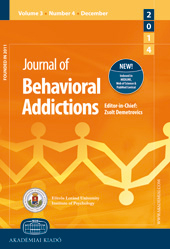Negative and positive urgency may both be risk factors for compulsive buying
Negative and positive urgency may both be risk factors for compulsive buying
Author(s): Paul Rose, Daniel J. SegristSubject(s): Psychology, Cognitive Psychology, Behaviorism, Substance abuse and addiction, Socio-Economic Research
Published by: Akadémiai Kiadó
Keywords: compulsive buying; impulsivity; positive urgency; negative urgency;
Summary/Abstract: Descriptions of compulsive buying often emphasize the roles of negative moods and trait impulsivity in the development of problematic buying habits. Trait impulsivity is sometimes treated as a unidimensional trait in compulsive buying research, but recent factor analyses suggest that impulsivity consists of multiple components that are probably best treated as independent predictors of problem behavior. In order to draw greater attention to the role of positive moods in compulsive buying, in this study we tested whether negative urgency (the tendency to act rashly while in negative moods) and positive urgency (the tendency to act rashly while in positive moods) account for similar amounts of variance in compulsive buying. Methods: North American adults (N = 514) completed an online survey containing the Richmond Compulsive Buying Scale (Ridgway, Kukar-Kinney & Monroe, 2008), established measures of positive and negative urgency (Cyders et al., 2007), ad hoc measures of buying-specific positive and negative urgency, measures of extraversion and neuroticism obtained from the International Personality Item Pool (http://ipip.ori.org/), and demographic questions. Results: In several multiple regression analyses, when demographic variables, neuroticism, and extraversion were controlled, positive urgency and negative urgency both emerged as significant predictors of compulsive buying. Whether the two urgency variables were domain-general or buying-specific, they accounted for similar amounts of variance in compulsive buying. Conclusions: Preventing and reducing compulsive buying may require attention not only to the purchasing decisions people make while in negative states, but also to the purchasing decisions they make while in positive states.
Journal: Journal of Behavioral Addictions
- Issue Year: 3/2014
- Issue No: 2
- Page Range: 128-132
- Page Count: 5
- Language: English

